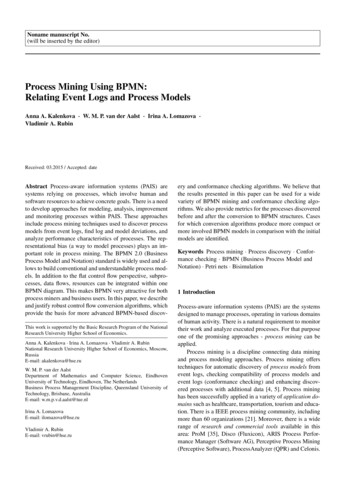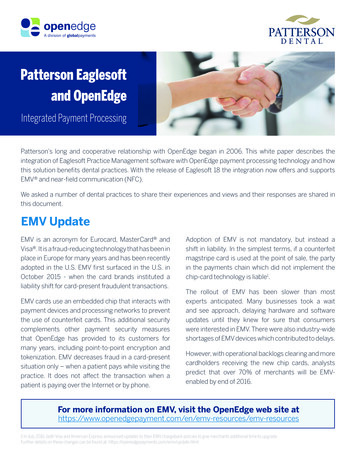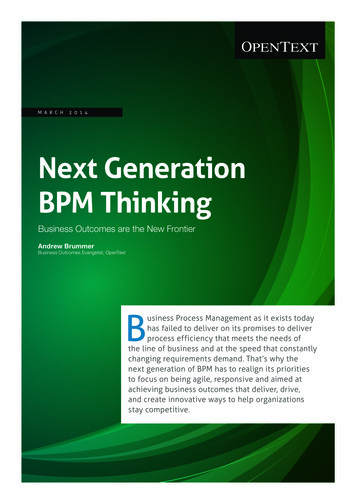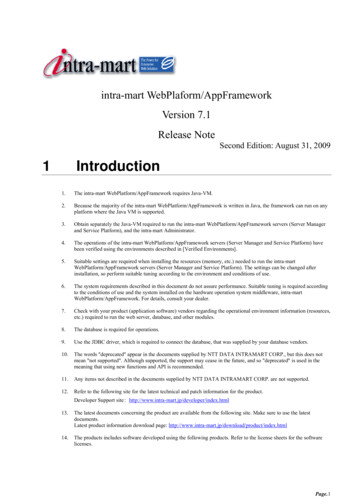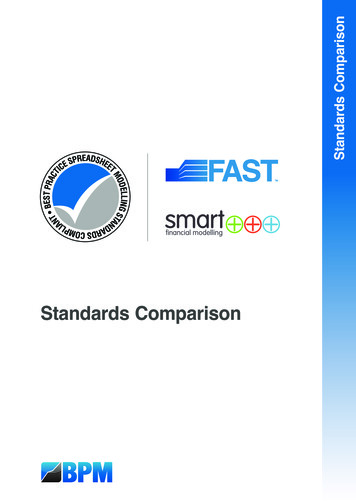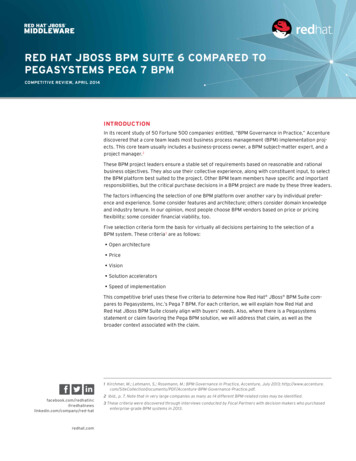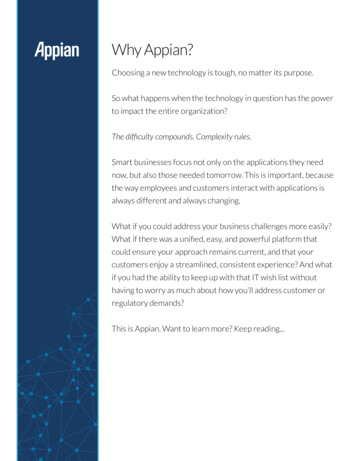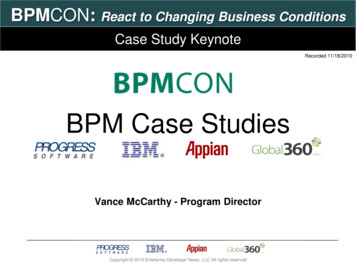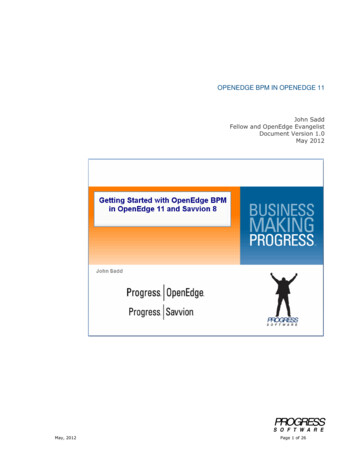
Transcription
OPENEDGE BPM IN OPENEDGE 11John SaddFellow and OpenEdge EvangelistDocument Version 1.0May 2012May, 2012Page 1 of 26
OpenEdge BPM in OpenEdge 11John SaddDISCLAIMERCertain portions of this document contain information about Progress Software Corporation’splans for future product development and overall business strategies. Such information isproprietary and confidential to Progress Software Corporation and may be used by you solely inaccordance with the terms and conditions specified in the PSDN Online (http://www.psdn.com)Terms of Use (http://psdn.progress.com/terms/index.ssp). Progress Software Corporationreserves the right, in its sole discretion, to modify or abandon without notice any of the plansdescribed herein pertaining to future development and/or business development strategies.Any reference to third party software and/or features is intended for illustration purposes only.Progress Software Corporation does not endorse or sponsor such third parties or software.This paper accompanies a multi-part presentation on OpenEdge BPM, using OpenEdge11 and Savvion version 8 together to create process-driven business applications. Inmany ways this is a follow-on to the series of videos covering the two products usingOpenEdge 10 and Savvion version 7, so if you haven’t used the products togetherbefore, you can start with a look at those materials. This series focuses on what’s newwhen you use the latest versions of the products together.It is already true in the latest releases of OpenEdge 10 and Savvion 7 that you canuse an OpenEdge database as the repository database for Savvion’s processinformation, and I begin by starting a database server for that database. You couldconfigure OpenEdge Explorer or Management to do this, but there’s a batch file,startdb.bat, created in the oebpmdb directory as part of the install to start thedatabase. Principally, it uses a .pf file to specify the startup parameters:@remecho off@rem@rem Start the oebpmdev database server@rem Generated on Wed 02/01/2012 at 15:42:55.99@remsetlocalset PATH ;;;;;;;C:\Program Files\Common Files\Microsoft sPowerShell\v1.0;C:\ProgramFiles\NTRU Cryptosystems\NTRU TCG Software Stack\bin\;C:\Program Files\Wave SystemsCorp\Gemalto\Access Client\v5\;C:\Program Files\Common Files\RoxioShared\DLLShared\;c:\Program Files\Microsoft SQL Server\100\Tools\Binn\;c:\ProgramFiles\Microsoft SQL Server\100\DTS\Binn\;C:\PROGRA 1\ABSOLU 1;C:\ProgramFiles\QuickTime\QTSystem\;C:\Program Files\Common Files\Microsoft rogress\OpenEdge11\BIN;set PROSQL LOCKWAIT TIMEOUT 302;call sql envcall proserve -pf oebpmdev.pfSo looking at that oebpmdev.pf file, you can see that the database server is startedon port 8910, as well as some other parameters that are needed by the way thedatabase is used:May, 2012Page 2 of 26
OpenEdge BPM in OpenEdge 11John Sadd## Server startup parameters file for the oebpmdev database# Generated on Wed 02/01/2012 at 15:42:55.96#-db oebpmdev-H 127.0.0.1-S 8910-n 75-bibufs 25-L 32000-B 5000-SQLStmtCache 200##I simple double-click on startdb.bat in the file Explorer to start the database itself.Once it’s started, I can go on and start up the other supporting pieces of theenvironment. In OpenEdge Explorer, I have a sample database configuration that mysimple example uses, and an AppServer where ABL business logic runs. I want tofocus just on the mechanics of how the new features of the environment work, so myexample is a very simple one that uses the familiar sports2000 database, so I starta server for the database:Then I start an AppServer configured to work with the SBM environment. This newAppServer configuration, called sbmbroker1, is defined for you as part of theOpenEdge 11 installation. There’s no particular reason why you would have to usethis one, but it’s one of several built in server configurations that come with theOpenEdge product. You can see that it’s configured to use the state-free operatingmode, so that each request is independent of every other request:May, 2012Page 3 of 26
OpenEdge BPM in OpenEdge 11John SaddThen in the Agent tab, I’ve added startup parameters to connect to the sports2000database server I just started. In addition, I’ve added a directory to the end of thepropath named CreditCheckDeploy. I’m going to define an AppServer for mydevelopment workspace, and this is the name of the directory that it will deployAppServer code to:Now I can start the AppServer, and I’m ready to move on:Next, from the Progress SBM8.0 sub-menu in the Windows Start menu, I can selectthe First Steps Console to bring up a useful set of operations to select from. If youMay, 2012Page 4 of 26
OpenEdge BPM in OpenEdge 11John Saddare starting up your environment for the first time after installing Savvion, you needto click the Prepare Repository link and let it configure the repository database:Otherwise, I select the Start JBOSS Servers link to start the servers that supportthe SBM runtime environment.This can take several minutes, and you need to wait until you see the message ineach of the two command windows that the ejb server and the portal server haveboth started. You’ll see a message similar to the one at the bottom of the display inthe two command windows shown here:Once that’s done, you can go back to the First Steps Console and select the linklabeled Launch Business Manager Portal. This starts the Savvion runtimeenvironment where you can start and monitor instances of the business processesyou’ve defined. During the product installation process you have an opportunity to setthe username and password that will be used for administration access to the SBMPortal. By default it’s ebms and ebms. As you can see below, I haven’t deployed anyprocesses yet, so there’s nothing much to look at in the Portal:May, 2012Page 5 of 26
OpenEdge BPM in OpenEdge 11John SaddNext I move on to Progress Developer Studio. This is a combined developmentenvironment that’s now supported in OpenEdge 11 and Savvion 8. To review thesteps you go through to combine both versions of Developer Studio in one Eclipsebased environment, you should consult the Web paper distributed with the producttitled OpenEdge Business Process Management Installation and Overview. Inparticular, during the Savvion install, select the checkbox labeled Configure Savvionwith OE, as shown below. This lets you use the same development tool for ABL codeand other work related to the OpenEdge side of the application, as well as buildingand deploying Savvion process models.So after starting the combined Developer Studio, I’m going to create a new project:May, 2012Page 6 of 26
OpenEdge BPM in OpenEdge 11John SaddI call it an OpenEdge Project, though as you’ll see, I’ll be adding Savvioncapabilities to it shortly:It’s going to be the world’s simplest credit check application, and this will be a projectthat deploys to the AppServer. That is, it won’t have its own OpenEdge user interface,and the ABL procedures I develop will be business logic run on the AppServer, in thiscase from the Savvion process:May, 2012Page 7 of 26
OpenEdge BPM in OpenEdge 11John SaddMoving on, you can see that the new project wizard has selected the checkbox labeledUse TTY for runtime. This is because I indicated that this is an AppServer projectwith no UI of its own:On the next wizard page, I can name the directory that will be used as the sourcefolder for all code that is destined to run on the AppServer. Code that I locate underthis directory will be published to the deployment folder I later name, which will bethe CreditCheckDeploy directory I showed you in the AppServer’s Propath when Iwas starting the AppServer in Explorer. I’ll just keep the name AppServer as thesource folder name. I haven’t defined an AppServer in Developer Studio yet, sonothing is displayed in that part of the page. I’ll get to that a little later.I had already defined a database connection in Developer Studio for sports2000, so Ijust select that to add to the project, and I’m done:May, 2012Page 8 of 26
OpenEdge BPM in OpenEdge 11John SaddBecause I defined an OpenEdge AppServer project, the tool invites me to open theOpenEdge Server perspective for my development, and I just answer Yes:Next I need to set up an ABL procedure to be called from Savvion and define theOpenEdge AppServer connection in Developer Studio. The simple credit check processneeds just a single procedure for the Savvion process to call in the OpenEdgeAppServer, so I’m going to import that into the project. Remember that DeveloperStudio will publish the contents of my AppServer directory to theCreditCheckDeploy target directory, so I start in the AppServer folder:May, 2012Page 9 of 26
OpenEdge BPM in OpenEdge 11John SaddI select Import, and Import again, and then indicate that I’m importing somethingfrom the File System:I select the folder where the ABL procedure is stored away, and select the procedure,GetCreditCheck.p:I click Finish, and now I can see the procedure in the AppServer folder. The proceduretakes a sports2000 customer name as input:May, 2012Page 10 of 26
OpenEdge BPM in OpenEdge 11John SaddThe procedure looks up the Customer name in the database, and returns the creditlimit and customer balance values. The procedure has been used in a larger examplewhere higher amounts were called for, so the code multiplies the values by --------------------------------File: GetCreditLimit.pDescription : Returns the Balance and Credit Limit for a named customer,multiplying both by 100 for use with the LoanApp ----------------------------*//* ***************************/* GetCreditLimit.p */Main Block*************************** */define input parameter pcCustNameas character no-undo.define output parameter pdCreditLimit as decimalno-undo.define output parameter pdBalanceas decimalno-undo.find Sports2000.Customer where Customer.Name pcCustName no-lock no-error.if available(Customer) thenassign pdCreditLimit Customer.CreditLimit * 100pdBalance Customer.Balance * 100.else assign pdCreditLimit ?pdBalance ?.In order to be able to run this procedure from the Savvion process, I need togenerate an annotation that goes at the top of the sourse code to define a serviceinterface. So I right-click the procedure, and under Progress OpenEdge, selectDefine Service Interface:The path to the procedure I want to generate the interface for is selected for me. Iconfirm this and click Next to preview the text of the annotation:May, 2012Page 11 of 26
OpenEdge BPM in OpenEdge 11John SaddI don’t need to change anything in the annotation, but I can take a look at it just topoint out what some of the components of the annotation are:The type is BPM. In my environment, with OpenEdge and Savvion installed, that’s theonly option for the type.The end result of what I’m doing is that Developer Studio is going to generate aspecial file containing a description of the parameters of this procedure, which will actas an intermediary between the Savvion environment and the OpenEdge AppServerwhich will actually execute the ABL procedure. The new file extension for that type offile is bizoe, since it connects a BizLogic process to OpenEdge. Think of this file asbeing much like the WSDL file you would need in order to invoke the ABL procedureas a Web service, as you would have done in OpenEdge 10. By default the .bizoe filewill have the same base name as the procedure file, with a different filenameextension. That’s what %FILENAME% indicates, so I leave that alone.Next, this is an external procedure, that is, a stand-alone ABL procedure that I wantto run, not an internal procedure inside a persistent procedure instance, so I leavethat as well.Finally, there are a couple of special case checkboxes if the ABL RETURN-VALUE issignificant, or if there will be an updated ProDataSet passed back. I don’t need thoseeither, so I’m done. If I look at the top of the procedure file itself, I can see thegenerated annotation in the source code:May, 2012Page 12 of 26
OpenEdge BPM in OpenEdge 11John Sadd@openapi.openedge.export FILE(type "BPM", operationName "%FILENAME%",useReturnValue "false", writeDataSetBeforeImage "false", executionMode "external").When I save the procedure, it is compiled with the annotation information in the .rfile. Note that you can specify which types of filename extensions you want to see inthe Project Explorer. If you drop down the Project Explorer View menu, and selectCustomize View, you see a list of all the possible filters that can be applied tofilenames. Because I have .r checked, they're filtered out and I don’t see .r files in theProject Explorer. You could uncheck this if you wanted to see .r files. I leave itchecked, since the .r file isn’t one I would normally want to select in the Explorer:The next step is therefore to generate the bizoe file itself. I right-click on theprocedure, and once again, under Progress OpenEdge, I select Generate BPMInvocation Files.With the bizoe file generated, the next thing I have to do is to define a connectionfrom Developer Studio to the AppServer that will run the GetCreditCheck procedure. Iright-click in the Servers view, and select New Server. What I’m defining here isactually not a new server, but a new connection from Developer Studio to that server,so keep that in mind:It’s an Open Edge AppServer, and I adjust the string that serves as an identifier for it.I put sbmbroker into the name, so that it’s clear which AppServer is used for theconnection. Next I need to identify the instance of OpenEdge Explorer that theMay, 2012Page 13 of 26
OpenEdge BPM in OpenEdge 11John Saddactual server is defined on. There is only got one instance running, but I selectConfigure just so you can see what things are available to be defined:In the Configuration, I select the one instance, Explorer 1, and then Edit:Port number 9090 is the default for OpenEdge Explorer. Then I need to make surethat the administrator username and password are valid. The connection wizardassumes admin and admin by default, so I select the password field, and replacethat with my own admin password. That’s the only thing that would be different fromthe defaults for my environment. Finally, I click Test Connection to make sure thatStudio can talk to Explorer:May, 2012Page 14 of 26
OpenEdge BPM in OpenEdge 11John SaddThat succeeds, so I’m finished with the Explorer connection definition. Havingestablished that connection, the New Server wizard populates the Broker list with alist of the AppServer brokers defined in my instance of Explorer. The one I want touse is sbmbroker1:Next I need to define the publish directory. This means, when I change ABL code inthe local AppServer sub-directory, which I designated as being the source for codedestined for the AppServer, where should Developer Studio copy that code to befound for testing? The answer is the directory that I added to the Propath for thesbmbroker1 AppServer, called CreditCheckDeploy. Note that you can configurewhether you want both source code and r-code published or not. I leave both thoseoptions checked, and continue on:May, 2012Page 15 of 26
OpenEdge BPM in OpenEdge 11John SaddNext I select the sample project to Add to the configured projects in DeveloperStudio, so that code is automatically published as I do development work:In the Servers view, the broker is shown as stopped, so to synchronize thisconnection definition with the AppServer I started in Explorer, I right-click on it, andselect Start. If I expand the broker now, I can see that the CreditCheck serverconnection is started and synchronized:What does it mean that it’s synchronized? Here’s the AppServer directory under theCreditCheck project:May, 2012Page 16 of 26
OpenEdge BPM in OpenEdge 11John SaddThis is the source directory for the AppServer code. You can see the GetCreditLimitprocedure that was imported into the directory, compiled, and the bizoe file that wasgenerated for it to define how it can be run from Savvion.If I switch to the CreditCheckDeploy directory, which is the target directory for theproject, you can see that the source procedure and the compiled r-code have beencopied there. This is the effect of configuring this project in Developer Studio andhaving it synchronize the code. This directory is in the Propath for the AppServeragent, so it will be found when I do a test that runs the procedure from the Savvionprocess. Note that the bizoe file is not deployed, because it is used on the client, inthis case by the Savvion process, to understand how to run the procedure on theAppServer:This finishes the configuration work for the project. In the next section of this paper Idefine the Savvion project and define a call out to the GetCreditLimit procedure usingthe new Savvion OpenEdge Adapter.Next I have to turn this OpenEdge project into one that can support a Savvionprocess design as well. This is the key capability that is enabled by creating acombined Developer Studio environment during the product installation.I right-click on the project, and in the Project Properties, I select Project Facet,and check on the Process facet, which adds the capability to define Savvionprocesses to the project:May, 2012Page 17 of 26
OpenEdge BPM in OpenEdge 11John SaddChecking on the Process facet also selects the Java facet, which Savvion requires.When I apply this change, Developer Studio opens a new diagram for a Savvionprocess, represented as a Savvion process template file with the extension spt:I create one user by dragging New User onto the diagram. When I’m prompted, Iname the user Finance. This creates an Activity for the Finance user:I then create a second Activity step for the Finance user.These two steps will executejust before and just after the process calls the ABL procedure on the AppServer. I alsoneed a Start step and an End step to make the diagram complete.May, 2012Page 18 of 26
OpenEdge BPM in OpenEdge 11John SaddNext the process needs three dataslots, which will map to the three parameters to theprocedure GetCreditLimit.p. The first I call CustomerName, and it shows part ofwhat is new with the new OpenEdge Adapter support in Savvion 8. In addition to thenative Savvion datatypes, there are now dataslot datatypes specific to calling out toOpenEdge. They’re listed under the header ABL Types. I can select Character forthis one:Most of the ABL types map to Savvion types, and in many cases can be usedinterchangeably, but you should use ABL types for dataslots that will map to ABLprocedure parameters to assure type compatibility, and to allow the use of the Nullvalue passed to or from ABL, which the Savvion types don’t support.To continue, I create a second dataslot with an ABL Datatype. This one is for theCreditLimit output parameter. Looking through the ABL types, I select Decimal:May, 2012Page 19 of 26
OpenEdge BPM in OpenEdge 11John SaddI need one more dataslot for the CustomerBalance output parameter. and that isDecimal as well. After I create that, I return to the diagram. I want to give moremeaningful names to the two Activity steps, so I call the first one BeforeCheck:I rename the form for the step as well. Now I need to go into the form and add adataslot to the form. Under the new User dataslots I select the CustomerName. Thisstep will run before I run GetCreditCheck, so I need to be able to enter a customername that I can then pass into GetCreditCheck.p:May, 2012Page 20 of 26
OpenEdge BPM in OpenEdge 11John SaddI need to do the same for the other Activity. This will be the AfterCheck step. In itsform I want to add all three of the ABL dataslots. The Customer Name won’t changefrom the Before step, but I let the form display it just to confirm that it has beenentered properly. The CreditLimit and the CustomerBalance will be returned fromthe procedure, so I need to display those to make sure the call worked properly.Now I need to create an instance of the new OpenEdge Adapter that Savvion 8supports. The easiest way to do that is just to drag the bizoe file from the ProjectExplorer onto the process diagram. As soon as I do that, the OpenEdge AdapterConfigurator opens:The great thing about this is that all the information needed for the call is embeddedin the bizoe file that was generated from the procedure. You can see the host name,port, and the AppServer name displayed. Putting these together gives Savvion theURL it needs to use to call out to the AppServer.The session model is properly displayed as Session-Free. The procedure name thatit will call is displayed, as are the three parameters to the procedure. Thus, unless Iwant to change the default configuration that was specified when Developer Studiogenerated the service interface annotation and the bizoe file, I don’t need to changeanything here. All the work is done for me.When I OK the configurator, I’m dropped into the dataslot mapping. The one inputparameter name is displayed, pcCustName, and from the Source dropdown on theMay, 2012Page 21 of 26
OpenEdge BPM in OpenEdge 11John Saddleft, I can select the CustomerName dataslot, which was defined as type ABLCharacter, to map to the input parameter:For the output parameters, I map pdCreditLimit to the CreditLimit dataslot, whichis of type ABL Decimal, and for pdBalance, I select the CustomerBalance Decimaldataslot. Now all the input and output parameters are mapped to the call, so the callis integrated right into the rest of the Savvion process steps:Back in the process diagram, the new step created by dragging the bizoe file onto thediagram has been transformed into an OpenEdge Adapter activity in the diagram.All I have to do to finish up is to connect all the steps together. The Start step, whichjust displays the instance name when the process is run, to the BeforeCheck step,where I can enter a Customer Name; the BeforeCheck step to the Adapter step,which will take the CustomerName as input and return the two decimal values; theAdapter output to the AfterCheck step, which displays the dataslots that aremapped to the output parameters; and the AfterCheck step to the End step:May, 2012Page 22 of 26
OpenEdge BPM in OpenEdge 11John SaddSelecting Check diagram from the diagram’s context menu confirms that thediagram is valid at least, so I save the process. Next I need to tell the SBM serverabout the process, so I right-click on that server in the Servers View and select Addand Remove:I select the CreditCheckProj process and add it to the resources for the SBM server:When I click Finish, Developer Studio synchronizes the SBM server, which meansthat the process is automatically deployed to the server.May, 2012Page 23 of 26
OpenEdge BPM in OpenEdge 11John SaddLet’s take a look in the SBM Portal to see if it’s there. TheCreditCheckProj process is installed on the server:If I select the link for the process, I start up an instance of the new process. The Startstep displays a default form with the Instance Name and an Instruction field. I canadd a distinctive number to the end of the Instance Name, and Create the newinstance:Remember that the activities in the process are assigned to the Finance user, so Ihave to log out and log back in to the SBM Portal as Finance, to see the first taskassigned to Finance, the BeforeCheck step:May, 2012Page 24 of 26
OpenEdge BPM in OpenEdge 11John SaddI can enter a valid customer name from the sports2000 database, and complete thestep:Now what should happen next? The BeforeCheck step should proceed to theOpenEdge Adapter step, which uses the customer name dataslot to populate theinput parameter to GetCreditCheck.p. The procedure is run and returns the twodecimal values, which are then transferred to the ABL Decimal dataslots. FinallyAfterCheck should run to display them:The Finance user now has an AfterCheck task to run, so I select that:May, 2012Page 25 of 26
OpenEdge BPM in OpenEdge 11John SaddThis form displays the data values returned from OpenEdge for Lift Tours. (Rememberthat they’ve been multiplied by 100.) I complete the step and my process is done:That completes this exercise in combining the OpenEdge and Savvion DeveloperStudio environments, and defining a Savvion process that uses the new SavvionOpenEdge Adapter to make a call out to an ABL procedure, making the definition ofthe call as simple as it could be.May, 2012Page 26 of 26
Any reference to third party software and/or features is intended for illustration purposes only. Progress Software Corporation does not endorse or sponsor such third parties or software. This paper accompanies a multi-part presentation on OpenEdge BPM, using OpenEdge 11 and Savvion version 8 together to create process-driven business applications.
